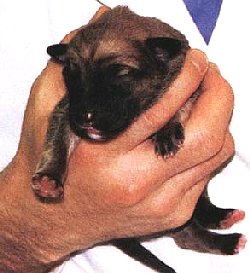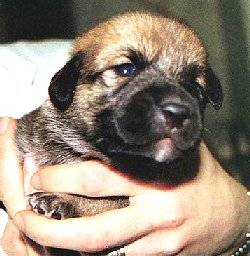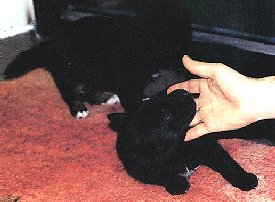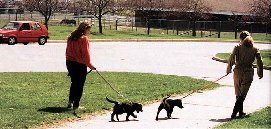By: Dr. Ed Bailey
|
The sure fire recipe for
producing behaviorally sound dogs, in fact the only way, is to start
with behaviorally sound pups. Piece of cake. All we need to do is
produce behaviorally sound pups. And that is not a piece of cake.
That is work, a lot of work, a lot of cost in dollars and mental
wear and tear, and no small amount of luck thrown in to
boot. |

One day old. Handling is important at this age for tactile and olfactory unput. The mild stress of early handling speeds development and prepares pus to take on problems more easily. |
a problem source, particularly through the first seven weeks, but continues to be a source through at least another five to seven weeks, up to 12 to 14 weeks of age.Genetically programmed problems can play a role all on its own and/or it can act to set the substrate on which physical and social environment will act, thereby enhancing or dampening the effects of less than optimum physical and social environments. Similarly physical environment effects can act to modulate the background against which social environment must perform. However, both these environmental factors can act independently as well. With all this impinging on the pup to be, how is it possible to produce behaviorally sound pups?
Though genetics and environment can interact at several different levels, to be practical we must consider them separately if we hope to control them. The first is genetically determined problems and their control. If a pup is to have a high probability of being behaviorally sound, it must come from behaviorally sound parents, which came from behaviorally sound grandparents. All uncles and aunts and their half brothers and half sisters should also be checked for behavioral problems. So how can a breeder possibly know the temperament of all those dogs? It is difficult and maybe next to impossible in our North American systems. But the exercise to find out everything possible about the progenitors is worth every minute spent on it.
The best system we have here is the field test and field trial programs. The most useful of the tests are those put on by the breed clubs with strong roots in the mother clubs in Europe, testing dogs using criteria patterned on the German system with a natural ability test for dogs under 16 months, a fall breeding test or intermediate level test for dogs up to 24 months, and the full utility test for fully trained dogs over 24 months. The breed clubs that follow this regimen will have the best and most complete records on temperament and genetic problems in general for potential parents and grand parents and beyond to include most of the genetically related dogs.
But most of the breeds do not have the deep roots in the European tradition and so are not tested by their own breed clubs. Therefore, second best is the field test/field trial competition system we have fallen into here in North America. Mostly we must assume that if a dog passed a test or placed in a trial, it can't be too scrambled. I'm not sure that is a valid assumption to make however. We must accept on faith that the judges were competent to evaluate inherited behavior problems, that existing problems were not successfully masked by training, and that the problem showed in the dog at the age it was tested and is not lying there dormant waiting for the dog to reach some certain developmental stage or for the right stimulus situation to come along to set the problem off. With our competitive penchant for "qualifying" or "finishing" at the youngest age possible, this is a shaky assumption to satisfy. Still, with all the inherent problems in the existing testing/trial system, this is the closest we can come to getting evidence on the background of the parents, grandparents, relatives and other progenitors. The records must be looked at and the decision to breed a male to a female tempered by the behavioral stability as was assessed by hopefully impartial judges.
Another way of assessing for behavior stability is personal knowledge of the dogs involved. Obviously, the breeder will have at least one, usually the bitch, often both male and female and so would be able to assess them or, it, if only one is breeder owned. Conceivably, a breeder might be familiar with several generations and the extended family, but this would be rare in this day and age. Or, another rarity, the breeder might have kept a handle on all dogs he ever produced and therefore have personal knowledge of the whole background of the parents to be. The problem is that this sort of evaluation is, unfortunately, too often tempered by an overload of kennel blindness and even the most glaring behavior (and physical) problems can be overlooked or rationalized into oblivion. Perhaps not as quantitatively assessed as a test or trial, breeder evaluation might be the best thing available. If so, use it, but be aware of your own fallibility.
The least objective is to have evaluations by people who own dogs that occur in the pedigree of the pups you hope to produce. With some judicious questioning, the breeder can assemble a relatively good behavioral history pedigree. But no one is overjoyed about admitting to a behavior problem because of the risk of looking like the problem is owner induced. That's why the judicious questioning is essential.
Evaluating the behavioral genetics of the parents is difficult at the best of times and is fraught with problems, but the honest, conscientious breeder must make every effort to do it with all the objectivity he/she can muster. And if finding a flaw, or a skeleton in the lineage closet, a breeder must have the moral strength to cancel the breeding and go find another stud, bitch or both. Because the breeder will not usually have any control over the behavior genetics background of the dogs intended for breeding, he must depend on every tool possible to avoid passing on genetically determined behavior problems, knowing that he is not totally certain but doing the best job of riding herd on it he possibly can.
A degree of control does shift to the breeder's court when the zygote starts to divide, implants in the uterus and the embryonic puppy begins to grow. Proper nutrition and care of the pregnant bitch is well documented. This is a major part of the physical environment. General good care of the bitch free of chemical, thermal, biological and psychological stress gives the pup the best start in life. Particularly during the last trimester developing pups are able to receive signals from the dam. These are chemical signals through transfer across the placental barrier, and auditory-like signals, detected as vibrations, of body sounds of the bitch such as heart beat, blood gushing, gut gurgling, sounds. Both chemical and auditory vibrations signals help establish the identity of the bitch to the pups after they are born. Olfactory cues established by chemical transfer within the uterus will further establish the identity of the bitch forming a late gestation period imprint of the bitch on the pups' nervous system.
Then on day 63 +/- a day or two, the pups are born. From birth on the bitch and the breeder, together are responsible for the social environment. Unless the bitch is herself suffering from a large behavior problem, she will do a satisfactory or better job of puppy socialization if given the time, actually starting before birth and going on well after weaning. From the dam and the siblings, each pup learns dog language, learns its social role and generally how to be a dog in a dog world. This is primary socialization and it will not be complete until pups are about 12 weeks old.
How to be a dog in a people world is strictly in the hands of the breeder. Many drop the ball- some for the reason of not having enough time, some because they don't believe in the need of people exposure, some because they just have no interest, they don't care, as in the puppy mill or mass production facilities. Fortunately, most breeders do take on the responsibility, and it is an awesome responsibility, by doing the best job they know how. My main purpose in writing this article is to explain how, and why and when to do what in order to help pups get the best social start in life through a solid, well planned secondary socialization process. And, socialization is exactly that, a process, not a one shot does it all thing.
The window of secondary socialization is open widest from birth through six weeks, before the development of the fear response which starts gradually in the fifth and sixth week and then rapidly escalates during the seventh to the tenth weeks. After six weeks old, the sponge like social learning in pups gradually decreases until the window closes when pups are 12 to 14 weeks of age. The primary and secondary socialization that has not gone on during the time when the window was open is never going to happen. Missing the opportunity for proper dog socialization by too early removal from litter will result in a dog having less than what would be considered normal social relationships with dogs. Leaving pups in litter with no human socialization past the window of opportunity will result in a dog that is fearful of people, nearly impossible to train. The breeder must ensure that neither happens.
Pups have developmental milestones and the job of the breeder will change as each milestone is passed. The most important developmental achievements coincide with the pups' ability to receive signals from outside. The first of the developmental steps begins at birth with the olfactory and tactile senses the only ones available to steer the pup to its mom and the milk bar. Eyes are not yet open so pup can only "see" differences in brightness much as we would see if we had our eyes lightly closed. Auditory canals are not open so "hearing" is still in terms of feeling vibrations. Neither vision nor audition will be giving the pup much information. The pup crawls and roots, using olfactory cues of direction of the teats and tactile, particularly tactile sensors around the mouth, tell pup when to start suckling and where. The pup is learning to recognize and find mom and gets rewarded with milk. Pup associates mom and siblings with something pleasant to reinforce it.
During the period that starts with birth, the breeder, with the help of other people, should get into this pleasant associations act by picking up and very gently handling pups for short periods daily. The positive effect is an olfactory and tactile association with humans and in a mild stress effect of being pulled from its warm bed with the resulting slight change in temperature. Research has demonstrated that this mild stress increases the growth rate, improves dogs' ability to learn tasks, improves coordination and generally speeds up later development thereby giving handled pups an advantage over pups not handled during the first two weeks.

Eyes open at two weeks of
age. Visual stimuli are |
Pups' eyes will open at 10
to 14 days of age. Auditory canals open at about three weeks on
average, so by three weeks of age visual cues and auditory cues can
be added to the olfactory and tactile modalities and the pups are
hitting on all four environmental perception cylinders. Though not
yet functioning in a totally coordinated way, that's the total
sensory pathways the dog will ever have. All four modalities firing
together and total absence of fear makes the three to six week
period the most critical for socializing on humans and on dogs. This
is when the breeder's responsibility is greatest. And what are the
breeder's responsibilities? The main one is the breeder must ensure
all associations the pup makes are
positive. |
|
So what should the pup be exposed to? At this time it is not necessary to be specific, the category is sufficient because all specific possibilities could not possibly be covered. One thing every dog will encounter is being physically handled, touched, pushed, prodded by just about everybody so it is essential to handle pups every day if possible. This means sometimes handle pups gently as was done in its first two weeks. It also means sometimes holding a pup back, rolling him over, rubbing his belly, his feet, lift his overly dangling ears and look in, lift his lips to look at his teeth, and end each slightly rough handling session with gentle petting and with quiet talking all the way through this phase of pup's life. This is a good time to discourage jumping up simply by always bending down |

Slightly rougher handling is
important to pups from |
and pet a pup only when he is sitting, standing or lying
down and never when he is trying to crawl up your leg or
arm.
Pups will be exposed to sudden noises as
adults so obviously it is imperative to expose them to noise as a pup. You
needn't fire a canon over their heads, but a good thunderstorm would be
nice or even an imitation one. General noise would suffice. Drop a pan,
rumble a piece of sheet metal, drive some nails, anything you can think of
that makes a noise. At 4 to 5 weeks pups will show reflexive startle
response to a sudden louder than normal sound. This is not fear though
they might raise their heads and might even shake a bit, they will return
to whatever they were doing pre-noise within a few seconds. The important
thing is do not run to their aid if they appear frightened. Running to the
pups and comforting them at this time will teach them very nicely to be
afraid of a loud noise. In wild dogs the bitch doesn't make any big deal
about thunder by comforting pups, she simply ignores it- and who ever
heard of a wolf or coyote or any wild dog being afraid of thunder or
lightning? They are not afraid because they learned not to be as pups
during the same 3 to 6 week period. Comforting an apparently frightened
pup when fear has not yet developed is reinforcing the startle response so
on the next noise the response will be more exaggerated. The breeder must
encourage the startle response and must let the pup return to normal
behavior on its own which is the normal thing for any developing nervous
system. It is what the dog will need to do as an adult. Deprived of the
sudden noises followed by the low level startle response and the quick
return to normal will mean an over reaction to noises followed by a
prolonged fearfulness when the pup passes the 7 to 8 week milestone when
fear is escalating. And this is the stuff gun shy dogs are made of. But
again, the exposure to the sudden loud sounds must be during the 3 to 6
week window when fear has not yet developed.
Handling along with talking to pups and exposure to noise are the things enlightened breeders (and that includes most) commonly do when raising a litter of pups. That is great, but there are some additional things that are not so commonly done. To again take a page from the wild dogs' book, pups need to learn to work for a living and they need to learn to cope with frustration. The breeder must set it up so pups work to get something they want and do it so that they sometimes fail. The easiest and most controllable is with food. When pups are 3 to 5 weeks old they will start to experiment with solid food. By the time they are 4 weeks old they are also gaining some fairly well coordinated mobility and so can begin crawling over ramped barriers to get to food dishes. Obviously the bitch would have to be removed to keep her from stepping over a gigantic 4-inch high barrier and slurping up the food. The height of barrier will need changing as pups get larger and more adept at going over it. Failure can be set up easily by putting down an empty dish or covering a filled one.
The purpose of the induced failure is to emulate the way a wild dog weans her pups. She frustrates them by walking away when the pups want to nurse, even pushes them away from teats while directing their attention toward her mouth. She then regurgitates semi-solid food for them. But she doesn't always just let them eat, she makes them work for it. Breeders usually just put down semi-solid food and let them at it. They become dependent and never do learn to cope with the frustration of failure in a non-volatile way without escalating to rage. Frustrating pups prevents them from becoming spoiled brats, which later can become dominance aggression in the adult dog. Inherited qualities is not the only cause of dominance aggression, given the potential, dogs are often trained to be that way during the 4 to 6 week period when it could be more easily controlled and even avoided. It is far easier to avoid it during the pup stage than to cure it in the adult that gets reinforced by getting what it wants through being aggressive.
Another reason for going through this controlled weaning-frustration training is that the bitch will be starting to wean pups herself at 3 to 4 weeks and will proceed gradually until pups are fully weaned at 7 to 8 weeks. The breeder will encourage independence and ease the way through the weaning process. The pup will be more emotionally stable as it enters the difficult 7 to 8 week period when it becomes more neophobic and when it becomes cautious and apprehensive when approaching or exposed to novel objects or situations.
A final exercise a breeder must go through during the 3 to 6 week window is to remove pups one at a time from the litter and mom. Starting slowly at the early age and gradually working to longer separation periods will serve best. Remove a pup, take it away to another room for hands on manipulation, play, even some rough housing for 5 to 10 minutes the first time, extending to 30 to 45 minutes or an hour away from litter mates when pups reach 7 to 8 weeks old. By approaching separation duration gradually the pup learns independence from litter and has new enriched environments challenging it. Taking pups for short walks outside on leash from week 5 onward is an excellent learning experience- if outside temperatures permit.
Being environmentally, physically and socially challenged throughout the 3 to 12 week socialization period is one of the most important factors in developing a stable, fearless pup that is expected to become a suitable companion for hunting and as a family pet. And most of our dogs are both hunter and family companion. Research on dogs at the Center of Applied Pet Ethology in the U. K. demonstrated that pups raised in environments lacking novelty and challenges were far more likely to develop into fearful animals when adult. They were more nervous and over-reactive when confronted by the threat of new situations.
The breeder then must be prepared to handle the pups from birth gently for examining, weighing, measuring, and just plain touching. Handling should continue, along with talking to pups from 3 to 10 or 12 weeks but handling should be done a bit more roughly as they get older, much the way aunts and uncles do in a wolf pack family, to get them used to a low level stress associated with this rougher treatment at the time when fear is low and resilience is high.
The breeder must also attempt to teach pups to handle frustration of failure or just being held back to simulate what the bitch teaches pups when weaning in wild dogs. Allowing pups to cope with frustration heads off the problem of frustration-to-the-point-of-rage in the adult dog. It teaches the dog to be in control of its own temperament.

At 9 1/2 weeks after being immunized, the pups have their first outing. Cars, horses, strange people and vehicles evoke no fear, only curiosity. |
The breeder must expose pups to sudden loud noises when fear is low so the pup can learn to handle the reflexive startle response gracefully and not prolong it or escalate it into a fear problem. And the pups must be separated from mom and siblings for increasing periods so they make all the social adjustments with people as well as with dogs and so they are prepared for separation, thus avoiding separation anxiety later in life. |
The breeder must expose pups to sudden loud noises when fear is low so the pup can learn to handle the reflexive startle response gracefully and not prolong it or escalate it into a fear problem. And the pups must be separated from mom and siblings for increasing periods so they make all the social adjustments with people as well as with dogs and so they are prepared for separation, thus avoiding separation anxiety later in life.
Sure, raising pups is labor intensive for both the bitch and the breeder. But the two, working together and supportive of each others efforts for 10 to12 weeks, will give pups the best chance to live up to their genetic potential. And indeed most dogs start with more genetic potential than is ever developed in them. Only the breeder can make a pup realize its potential. Training just refines it.
Next Article: GIVING PUPS A HEAD START